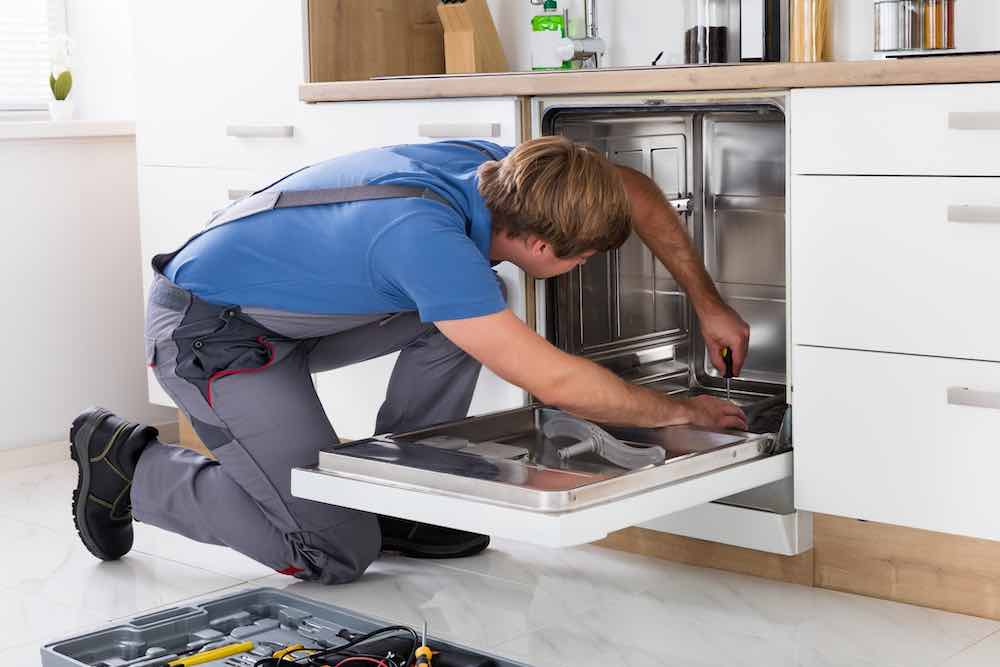Have you ever noticed a puddle of water on your kitchen floor? Does your dishwasher leak from the bottom even when it’s not running? This is a common problem that many people face, and it can be quite problematic to handle.
In this guide, I’ll walk you through the steps to fix this issue once and for all.
Dishwasher Leaking From Bottom When Not Running [Fixed]

Step 1: Identify the Source of the Leak
Before you start fixing anything, it’s important to identify where the leak is coming from. Start by turning off the dishwasher and unplugging it from the power source. Then, remove the bottom panel of the dishwasher to get a better view of what’s going on inside. Check for any obvious signs of water or moisture, such as wet insulation, a wet floor pan, or standing water.
If you’re having trouble identifying the source of the leak, try filling the dishwasher with a few inches of water and then running it for a few minutes. This should help you pinpoint where the water is coming from.
Step 2: Check the Door Gasket
The door gasket is one of the most common reasons for a dishwasher to leak from the bottom is a faulty door gasket. The door gasket is a rubber seal that runs along the perimeter of the dishwasher door, and it prevents water from leaking out during a wash cycle. Over time, the gasket can become worn or damaged, which can cause leaks.
To check the door gasket, inspect it for any visible signs of wear or damage. Look for cracks, tears, or deformations in the rubber. If you notice any issues, you’ll need to replace the gasket.
To replace the door gasket, start by ordering a replacement gasket from your dishwasher manufacturer or a reputable appliance parts supplier. Then, remove the old gasket by gently pulling it out of its channel. Clean the channel thoroughly with a damp cloth to remove any debris or buildup, and then install the new gasket by pushing it into place.
Step 3: Inspect the Dishwasher Tub
If the door gasket isn’t the problem, the next thing you would want to check is the dishwasher tub. Over time, the tub can develop cracks or other damage that can cause water to leak out. Inspect the tub carefully for any signs of damage, such as cracks, holes, or warping.
If you notice any damage, you’ll need to replace the tub. This is a more involved repair that should be done by a professional, as it involves disconnecting the dishwasher from its power source and water supply and removing the old tub before installing a new one.
Step 4: Check the Drain Hose
Another common reason for a dishwasher to leak from the bottom is a clogged or damaged drain hose. The drain hose carries water out of the dishwasher and into the sink or garbage disposal. If the hose becomes clogged or damaged, water can back up and leak out of the dishwasher.
To check the drain hose, start by disconnecting it from the sink or garbage disposal. Inspect it carefully for any signs of damage or clogs. If you notice any damage, you’ll need to replace the hose. If there are any clogs, try using a plumbing snake to clear them out.
Step 5: Check the Float Switch
The float switch is a small plastic or metal device located near the bottom of the dishwasher. It’s responsible for shutting off the water supply to the dishwasher if the water level gets too high. If the float switch becomes stuck or damaged, it can cause water to continue to fill the dishwasher even when it’s not running, which can lead to leaks.
To check the float switch, start by locating it near the bottom of the dishwasher. Gently lift it up and down to make sure it moves freely. If it’s stuck or damaged, you’ll need to replace the float switch. You can order a replacement from your dishwasher manufacturer or a reputable appliance parts supplier.
Step 6: Check the Inlet Valve
The inlet valve of the dishwasher controls the flow of water into the dishwasher. If the valve becomes stuck or damaged, it can cause water to continue to flow into the dishwasher even when it’s not running, which can lead to leaks.
To check the inlet valve, start by turning off the water supply to the dishwasher. Then, remove the bottom panel of the dishwasher and locate the inlet valve. Inspect it carefully for any signs of damage or blockages. If you notice any issues, you’ll need to replace the inlet valve.
Step 7: Call a Professional
If you’ve tried all of the above steps and you’re still experiencing leaks from your dishwasher, it may be time to call in a professional. A qualified technician can diagnose the issue and make any repairs if necessary. This is especially important if you’re not comfortable working with electrical or plumbing systems.
How to Prevent Dishwasher From Leaking When not Running
Preventing your dishwasher from leaking when it’s not running will save you a lot of time that would be spent on repairs. It could also save you any cost you would incur from the repairs. The tips below help you avoid leaks and keep your dishwasher running smoothly:
- Check the Door Seal Regularly: Take your time to check the door seal regularly for signs of wear or damage. The door seal should be replaced if you notice any signs.
- Don’t Overload the Dishwasher: Avoid overloading your dishwasher. If you’re not sure about the capacity, check the manufacturer’s recommendations
- Clean the Filter Regularly: Cleaning the water filter regularly will prevent leaks and keep the dishwasher working perfectly.
- Run the Dishwasher Regularly: Run the dishwasher regularly to keep keeping the components in good working order. Be sure to run the dishwasher at least once a week, even if it’s not full. This will help to prevent the seals and other components from drying out and cracking.
Related:
- GE Dishwasher Diagnostic Mode Instructions
- GE Dishwasher No Lights on Control Panel [FIXED]
- GE Dishwasher Fuse Location Revealed
- Samsung Dishwasher Diagnostic Mode Instructions
- GE Microwave Fuse Location & Replacement Guide
- Kitchenaid Dishwasher Diagnostic Mode Explained
- Kohler Touchless Faucet Not Working: Causes & Fixes
- Best Settings for Miele Coffee Machine
- Cuisinart Dehydrator Temperature Settings Guide
- Cuisinart Coffee Grinder Settings Explained



![GE Dishwasher No Lights on Control Panel [FIXED] GE Dishwasher No Lights on Control Panel [FIXED]](https://homestuffmag.com/wp-content/uploads/2023/07/ge-dishwasher-fuse-location-211x150.jpg)
![Whirlpool WRX735SDBM02 Ice Maker Not Working [FIXED] Whirlpool WRX735SDBM02 Ice Maker Not Working [FIXED]](https://homestuffmag.com/wp-content/uploads/2023/04/Whirlpool-WRX735SDBM02-Ice-Maker-Not-Working-211x150.jpg)